Dell XPS 13 Developer Edition, or Ubuntu comes on ultrabooks
When I was asked to get acquainted closer with the Dell XPS 13 Developer Edition Ultrabook, I honestly resisted for a long time. First, about XPS 13 on Habré is already written. I did it personally a good one and a half years ago. Secondly, the Developer Edition in the title means that the ultrabook works on Ubuntu 12.04 LTS. Linux is another planet for me. I flew there a few dozen times, but each time I came back. And I do not remember exactly whether he left himself with his head held high, or the operating system gave me a strong kick to speed up ...
As a result, the acquaintance did take place. And suddenly it turned out that the XPS 13 is completely different from the one studied a year and a half ago, and Ubuntu itself has become so convenient for everyday work that I have been working only on it for several days, without experiencing the slightest discomfort. And this post is also entirely written in LibreOffice Writer.
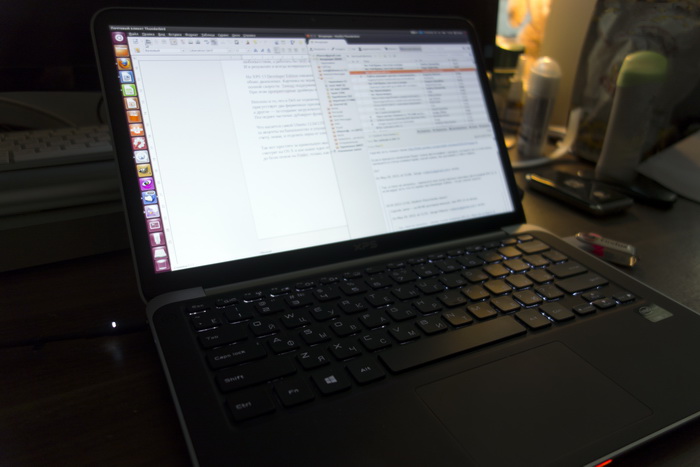
')
Laptops with Linux preinstalled on the shelves before. But they all belonged to the so-called budget segment because of a simple filling. Yes, and there they put Linux like a manufacturer and did not expect that someone would work seriously in it. Remember the joke about Internet Explorer - an application designed to run once to install a normal browser? So with those Linux-laptops were similar sensations.
XPS 13 Developer Edition ruthlessly tears the template. This is not just another state employee, but a modern ultrabook in all respects with very serious characteristics. Judge for yourself.
Its Core i7-3537U processor (third generation Core, Ivy Bridge family) has a nameplate frequency of 2 GHz, but under load it accelerates to 3.1 GHz.
The 13.3-inch screen uses FullHD-matrix, made by technology IPS. Clarity, rich shades, viewing angles - everything is fine. For greater durability, the matrix is protected from external influences by the Gorilla Glass plate.
The amount of RAM 8 GB. The capacity of the built-in drive is 256 GB, and this, as you might guess from the figure, is not a regular hard drive, but a fast SSD.

The body is made of aluminum, and its base is made of hydrocarbon fiber. The latter was done not to save money, but in the name of caring for the user. From my own experience, I know that putting a metal laptop on bare knees is not very pleasant, but girls have to do it regularly.
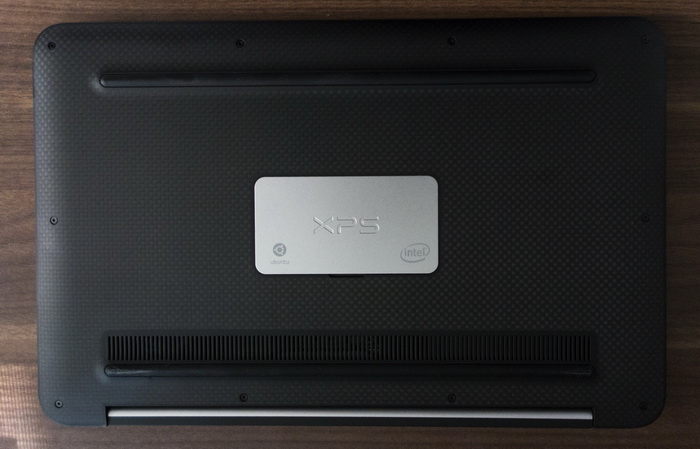
Back part: nice and practical
To connect peripheral devices, there are two USB 3.0 connectors, and one is designed to recharge all sorts of gadgets, even if the ultrabook is turned off. The capacity of a 6-cell battery is 47 Wh, and its full charge lasts an average of 5 hours. If you handle the "heavy" illustrations and watch flash-videos, the allotted time will be reduced to 4 hours. If, on the contrary, it is thoughtful to read something from the screen, muting the brightness of the screen and turning off the keyboard backlight - enough for 6.5 hours. But the average is exactly 5.
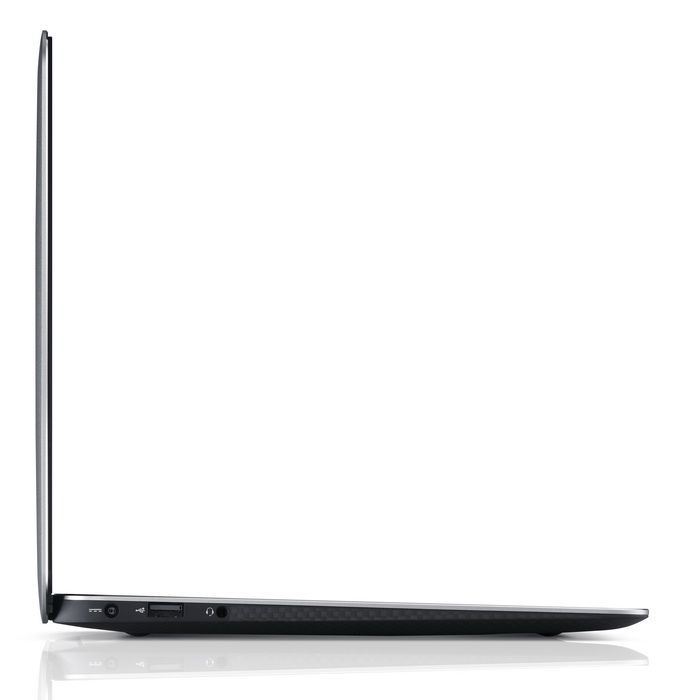
There is support for dual-band WiFi with a connection speed of up to 300 Mbps. The adapter (Intel Centrino Advanced-N 6230) also includes Bluetooth 3.0, so you can connect wireless headsets, speakers, mice and whatever you want.
In general, no simplifications. Really modern and powerful ultrabook. And here they put Ubuntu on this beauty ...
Good!
As I wrote above, I installed Linux on my computers more than once or twice. It has always been laptops - from the first netbooks to desktop with a large screen diagonal. There was usually no problem with the installation process itself, but in the absolute majority of cases, some inconsistencies with the drivers began. Non-working WiFi, nonstandard screen resolution, lack of sound in the speakers - I don’t even remember everything. Among my acquaintances there are several experienced linuxoids, and they always tried to help. “It’s still very simple,” said these kind people, “You just need to type a few commands in the terminal, and everything will work!” I typed these commands (they usually occupied half the screen), and something really began to work. But then some kind of system update arrived, and WiFi fell off completely. And the old spells in the terminal did not help.
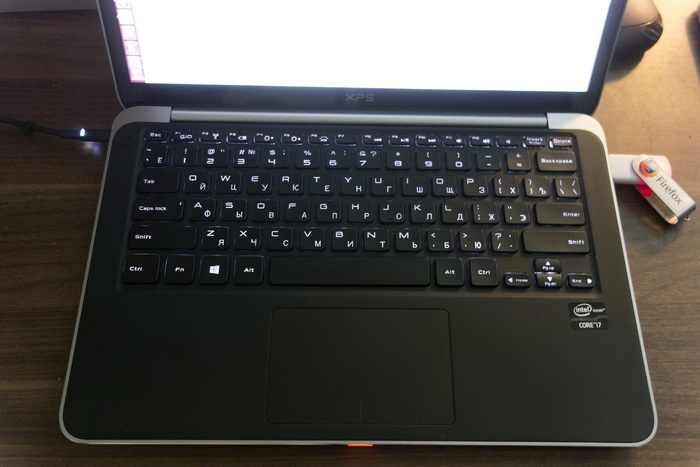
On the keyboard, the Start key is easily detected. This is the only thing that reminds of Windows.
For this nice fussing with setting up the hardware, the joys of Linux somehow did not reach. Curiosity is curiosity, and working without WiFi or with a cloudy image on the screen is somehow uncomfortable. And as a result, I always went back to Windows.
There are no compatibility issues on the XPS 13 Developer Edition. At all. None
WiFi works in both bands. Picture on the screen in FullHD. The sound is good. USB 3.0 runs at full speed. The touchpad supports gestures, like flicking the screen with two fingers. At the same time, proprietary drivers are not used in the system - all are correct, native.

Perhaps many have already seen XPS 13 Developer Edition on the main page of Ubuntu.com
Not bad, but Dell didn’t limit it to pouring a standard distribution. In the list of applications there are two proprietary applications - one is responsible for installing and updating drivers, and the other for creating a boot disk, restoring the system, and BIOS firmware. The latter partially duplicates the functionality of the OS itself, but there is no unnecessary care.
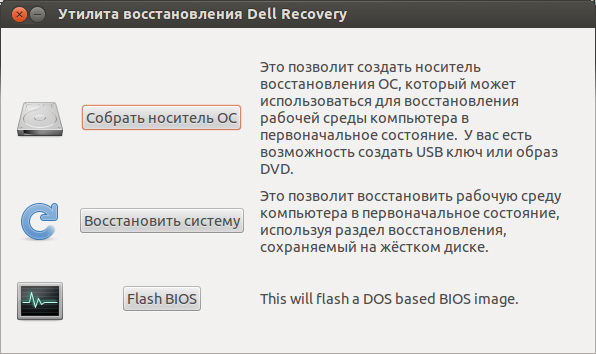
As for Ubuntu 12.04 LTS itself, I apologize in advance to more experienced readers for accents on platitudes and the omission of important points. The system for me, by and large, is new, and it is not always possible to separate the wheat from the chaff.
So forgive me for a seditious thought, but it seems that the guys from Canonical look very closely at OS X and take some ideas from there. For example, the Ubuntu file manager is just like the Finder. Only, it seems to me, it works better. The system settings menu also makes you think of Apple’s laconic design ... I don’t know who inspired anyone, but as a result, it’s very convenient to use Ubuntu. There are no problems - where to press, what to open? Everything is intuitively understandable even to someone inexperienced in Linux like me.
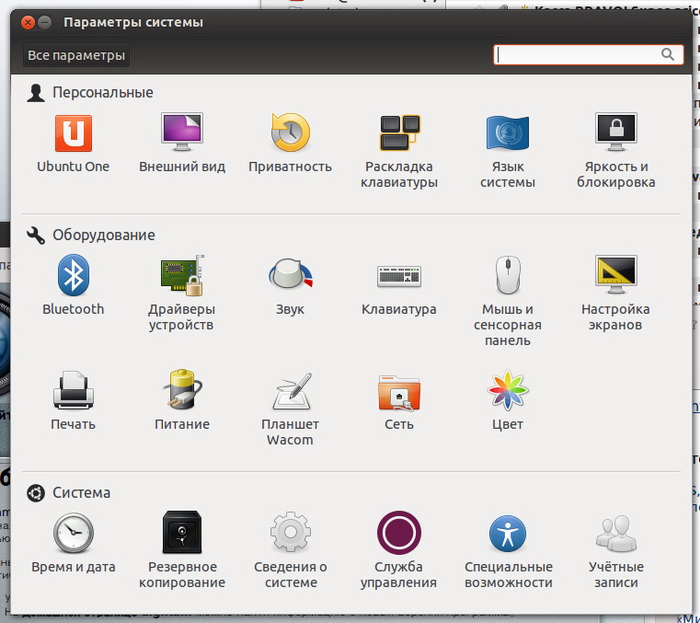
Something painfully familiar ...
As expected, LibreOffice was originally installed on the ultrabook. Probably, like all free office suites, it gives slack when working with complex presentations, but in my articles there is usually no sort of exquisite formatting, so I can not fault it.
I used the Thunderbird e-mail client (also preinstalled) for a long time on Windows, but several versions in a row were eating the resources of the system too violently, and in the end I had to escape to Outlook. There and caught on. On Ubuntu, Thunderbird behaves decently, easily picked up a box from Gmail and so far does not cause a desire to escape. Well, if you suddenly discover that appetites have grown, you can always go to the web interface, since they are now quite decent in almost all free mail services.
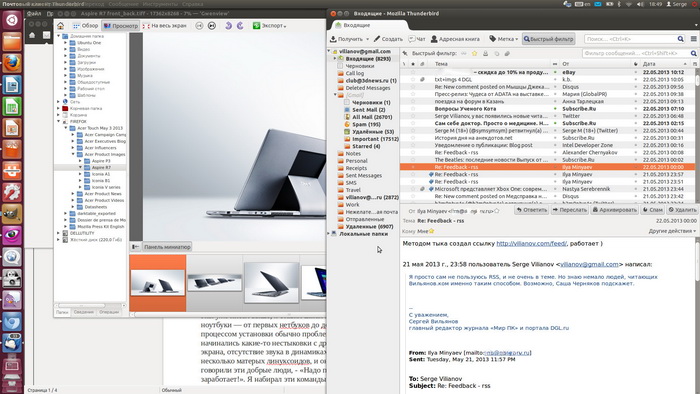
I set up the Pidgin IM client myself, although it was probably possible to get along with the pre-installed Empathy. But the built-in application store is really good. Previously, there was somehow ... not rich, but now I immediately picked up a photo viewer (Gwenview), a photo editor (Gimp) and a program for converting RAW produced by my Sony camera (digiKam). At this, my needs have so far been limited, but the software in the store is really a lot, both traditionally free and for money. A convenient rating system in combination with Google allows you to quickly find the right option.

Perhaps the only thing I could not do was set up a seal. I have a pretty fresh model of Epson L210 MFP, and it does not appear in the driver database. Given the wealth of this base, I am almost sure that over time the driver will appear, but it interests me more for order. The fact is that in the past three years I have not printed a single page from any of my mobile laptops. No need. And if so, is it worth making any complaints about Ubuntu?
Day replaces day, and the desire to demolish Ubuntu does not arise. Everything works fine. Iron is serviced correctly - even the screen lights up and goes out smoothly, not jerk (this is a trifle that says a lot). All the software is there. So what more could you want? If tomorrow you need to go on a business trip, I can take this XPS 13, and it will definitely cope with all work tasks. And I will not hurt him on the table in a fit of character mismatch.
But here we come to one important question ...
Dear developers
The following is written on the Dell website:
“The Dell XPS 13 Developer Edition is running Ubuntu 12.04LTS, a convenient operating system for developers of cloud systems in a version with long-term support.
In addition to the Ubuntu 12.04LTS OS, the XPS 13 Developer Edition laptop is equipped with the following components:
• Basic set of tools and utility programs for developers.
• Cloud system launcher (beta project): allows you to create a “micro-cloud” on a laptop, simulating the environment at an appropriate scale, and then easily deploying this environment in the cloud.
• Profile Tool (beta project): provides access to a library of profiles, such as Ruby and Android, for quick customization of development environments and tool chains. ”
There were times when I could call myself a developer, about ten years ago. And therefore it is difficult for me to imagine how much all this is useful for people working in the field of software and services. You don’t really want to take the word and try to mislead the reader.
In this regard, questions:
1) What are the advantages for people who are actively using Linux, has an ultrabook with Ubuntu pre-installed and configured compared to peers on the Microsoft platform?
2) How can a lightweight and powerful laptop with Ubuntu enhance and expand your work experience and user experience?
Answers to them, most likely, will require a certain amount of time. Understanding this, I agreed with Dell that the author of the comment, which gained the most advantages, will receive a copy of XPS 13 Developer Edition that I have visited for a long test. Well, if, of course, this is not a furious joke about red eyes - then you have to pass the ultrabook to the second place.

In the meantime, the winner has not yet decided, I will continue to use this interesting machine with a friendly and coherent operating system.
A week ago, I could not even imagine that someday I would say this about Ubuntu ...
PS The retail price of this model is $ 60-80 cheaper than its counterpart with Windows pre-installed. And the latter will cost about 50 000 rubles.
As a result, the acquaintance did take place. And suddenly it turned out that the XPS 13 is completely different from the one studied a year and a half ago, and Ubuntu itself has become so convenient for everyday work that I have been working only on it for several days, without experiencing the slightest discomfort. And this post is also entirely written in LibreOffice Writer.

')
Laptops with Linux preinstalled on the shelves before. But they all belonged to the so-called budget segment because of a simple filling. Yes, and there they put Linux like a manufacturer and did not expect that someone would work seriously in it. Remember the joke about Internet Explorer - an application designed to run once to install a normal browser? So with those Linux-laptops were similar sensations.
XPS 13 Developer Edition ruthlessly tears the template. This is not just another state employee, but a modern ultrabook in all respects with very serious characteristics. Judge for yourself.
Its Core i7-3537U processor (third generation Core, Ivy Bridge family) has a nameplate frequency of 2 GHz, but under load it accelerates to 3.1 GHz.
The 13.3-inch screen uses FullHD-matrix, made by technology IPS. Clarity, rich shades, viewing angles - everything is fine. For greater durability, the matrix is protected from external influences by the Gorilla Glass plate.
The amount of RAM 8 GB. The capacity of the built-in drive is 256 GB, and this, as you might guess from the figure, is not a regular hard drive, but a fast SSD.

The body is made of aluminum, and its base is made of hydrocarbon fiber. The latter was done not to save money, but in the name of caring for the user. From my own experience, I know that putting a metal laptop on bare knees is not very pleasant, but girls have to do it regularly.

Back part: nice and practical
To connect peripheral devices, there are two USB 3.0 connectors, and one is designed to recharge all sorts of gadgets, even if the ultrabook is turned off. The capacity of a 6-cell battery is 47 Wh, and its full charge lasts an average of 5 hours. If you handle the "heavy" illustrations and watch flash-videos, the allotted time will be reduced to 4 hours. If, on the contrary, it is thoughtful to read something from the screen, muting the brightness of the screen and turning off the keyboard backlight - enough for 6.5 hours. But the average is exactly 5.

There is support for dual-band WiFi with a connection speed of up to 300 Mbps. The adapter (Intel Centrino Advanced-N 6230) also includes Bluetooth 3.0, so you can connect wireless headsets, speakers, mice and whatever you want.
In general, no simplifications. Really modern and powerful ultrabook. And here they put Ubuntu on this beauty ...
Good!
As I wrote above, I installed Linux on my computers more than once or twice. It has always been laptops - from the first netbooks to desktop with a large screen diagonal. There was usually no problem with the installation process itself, but in the absolute majority of cases, some inconsistencies with the drivers began. Non-working WiFi, nonstandard screen resolution, lack of sound in the speakers - I don’t even remember everything. Among my acquaintances there are several experienced linuxoids, and they always tried to help. “It’s still very simple,” said these kind people, “You just need to type a few commands in the terminal, and everything will work!” I typed these commands (they usually occupied half the screen), and something really began to work. But then some kind of system update arrived, and WiFi fell off completely. And the old spells in the terminal did not help.

On the keyboard, the Start key is easily detected. This is the only thing that reminds of Windows.
For this nice fussing with setting up the hardware, the joys of Linux somehow did not reach. Curiosity is curiosity, and working without WiFi or with a cloudy image on the screen is somehow uncomfortable. And as a result, I always went back to Windows.
There are no compatibility issues on the XPS 13 Developer Edition. At all. None
WiFi works in both bands. Picture on the screen in FullHD. The sound is good. USB 3.0 runs at full speed. The touchpad supports gestures, like flicking the screen with two fingers. At the same time, proprietary drivers are not used in the system - all are correct, native.

Perhaps many have already seen XPS 13 Developer Edition on the main page of Ubuntu.com
Not bad, but Dell didn’t limit it to pouring a standard distribution. In the list of applications there are two proprietary applications - one is responsible for installing and updating drivers, and the other for creating a boot disk, restoring the system, and BIOS firmware. The latter partially duplicates the functionality of the OS itself, but there is no unnecessary care.

As for Ubuntu 12.04 LTS itself, I apologize in advance to more experienced readers for accents on platitudes and the omission of important points. The system for me, by and large, is new, and it is not always possible to separate the wheat from the chaff.
So forgive me for a seditious thought, but it seems that the guys from Canonical look very closely at OS X and take some ideas from there. For example, the Ubuntu file manager is just like the Finder. Only, it seems to me, it works better. The system settings menu also makes you think of Apple’s laconic design ... I don’t know who inspired anyone, but as a result, it’s very convenient to use Ubuntu. There are no problems - where to press, what to open? Everything is intuitively understandable even to someone inexperienced in Linux like me.

Something painfully familiar ...
As expected, LibreOffice was originally installed on the ultrabook. Probably, like all free office suites, it gives slack when working with complex presentations, but in my articles there is usually no sort of exquisite formatting, so I can not fault it.
I used the Thunderbird e-mail client (also preinstalled) for a long time on Windows, but several versions in a row were eating the resources of the system too violently, and in the end I had to escape to Outlook. There and caught on. On Ubuntu, Thunderbird behaves decently, easily picked up a box from Gmail and so far does not cause a desire to escape. Well, if you suddenly discover that appetites have grown, you can always go to the web interface, since they are now quite decent in almost all free mail services.

I set up the Pidgin IM client myself, although it was probably possible to get along with the pre-installed Empathy. But the built-in application store is really good. Previously, there was somehow ... not rich, but now I immediately picked up a photo viewer (Gwenview), a photo editor (Gimp) and a program for converting RAW produced by my Sony camera (digiKam). At this, my needs have so far been limited, but the software in the store is really a lot, both traditionally free and for money. A convenient rating system in combination with Google allows you to quickly find the right option.

Perhaps the only thing I could not do was set up a seal. I have a pretty fresh model of Epson L210 MFP, and it does not appear in the driver database. Given the wealth of this base, I am almost sure that over time the driver will appear, but it interests me more for order. The fact is that in the past three years I have not printed a single page from any of my mobile laptops. No need. And if so, is it worth making any complaints about Ubuntu?
Day replaces day, and the desire to demolish Ubuntu does not arise. Everything works fine. Iron is serviced correctly - even the screen lights up and goes out smoothly, not jerk (this is a trifle that says a lot). All the software is there. So what more could you want? If tomorrow you need to go on a business trip, I can take this XPS 13, and it will definitely cope with all work tasks. And I will not hurt him on the table in a fit of character mismatch.
But here we come to one important question ...
Dear developers
The following is written on the Dell website:
“The Dell XPS 13 Developer Edition is running Ubuntu 12.04LTS, a convenient operating system for developers of cloud systems in a version with long-term support.
In addition to the Ubuntu 12.04LTS OS, the XPS 13 Developer Edition laptop is equipped with the following components:
• Basic set of tools and utility programs for developers.
• Cloud system launcher (beta project): allows you to create a “micro-cloud” on a laptop, simulating the environment at an appropriate scale, and then easily deploying this environment in the cloud.
• Profile Tool (beta project): provides access to a library of profiles, such as Ruby and Android, for quick customization of development environments and tool chains. ”
There were times when I could call myself a developer, about ten years ago. And therefore it is difficult for me to imagine how much all this is useful for people working in the field of software and services. You don’t really want to take the word and try to mislead the reader.
In this regard, questions:
1) What are the advantages for people who are actively using Linux, has an ultrabook with Ubuntu pre-installed and configured compared to peers on the Microsoft platform?
2) How can a lightweight and powerful laptop with Ubuntu enhance and expand your work experience and user experience?
Answers to them, most likely, will require a certain amount of time. Understanding this, I agreed with Dell that the author of the comment, which gained the most advantages, will receive a copy of XPS 13 Developer Edition that I have visited for a long test. Well, if, of course, this is not a furious joke about red eyes - then you have to pass the ultrabook to the second place.

In the meantime, the winner has not yet decided, I will continue to use this interesting machine with a friendly and coherent operating system.
A week ago, I could not even imagine that someday I would say this about Ubuntu ...
PS The retail price of this model is $ 60-80 cheaper than its counterpart with Windows pre-installed. And the latter will cost about 50 000 rubles.
Source: https://habr.com/ru/post/181970/
All Articles